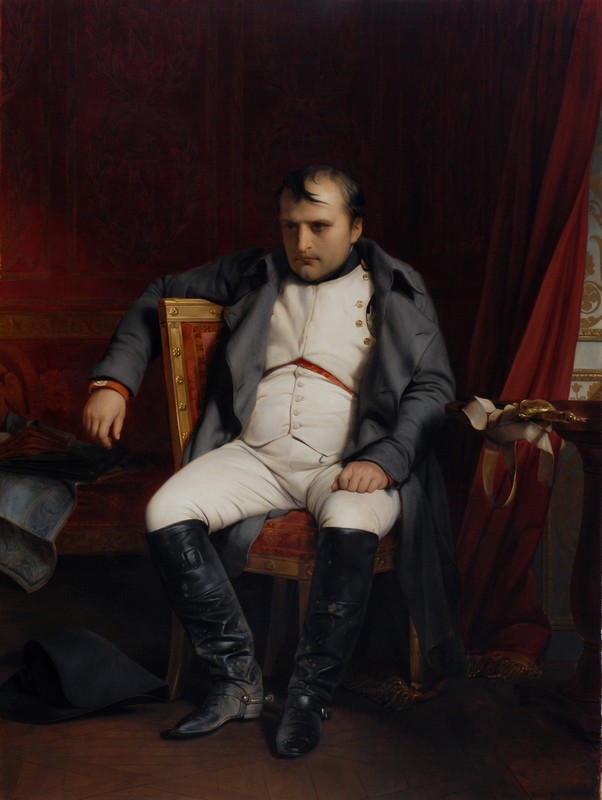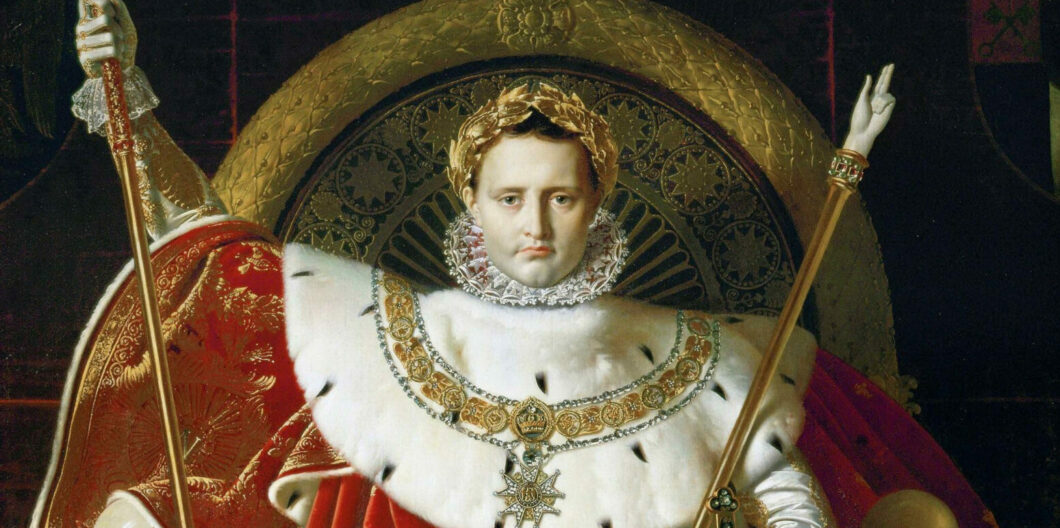Moby-Dick’s author believed that when we use our liberty to discharge our duties, we express the highest that humanity is capable of.
The Other Napoleon
Ridley Scott’s forthcoming Napoleon may be his greatest epic yet—or a total stinker. Either way, watching Joaquin Phoenix portray Bonaparte, it will be difficult, perhaps impossible, to fully forget Danny DeVito. DeVito’s version exists of course only in the imaginations of viewers of Get Shorty, the 1995 movie in which he plays a conceited method actor playing Bonaparte. These contradictory versions of the first modern tyrant, one sublime, one silly, have a long and entwined history. Since he came to prominence with “a whiff of grapeshot” in 1795, the world has been divided between those who revere him and those who blow raspberries.
One of several brilliant generals created by the French Revolution, Bonaparte’s genius was acting the part and having someone handy with a brush around to immortalise the moment. More than his French rivals—Hoche, Jourdan, or Moreau—the wily Corsican grasped that publicity in Paris mattered more than battlefield realities. We still see him refracted through the propaganda he commissioned and, equally, that of those who despised him.
Despatched to Italy in 1796, Bonaparte knew Parisians craved news of the wars fought in their name. He did a Berlusconi, founding newspapers to report the achievements of a certain dashing young general who never lost. In this, he was emulating his hero, Julius Caesar, who always let his fellow Romans know how well he was doing on campaign. Arresting images mattered more than bulletins in an age of patchy literacy, but for inventing the Napoleonic icon, a meme avant la lettre, we must thank Joséphine.

His new wife commissioned a gifted French painter in Milan to commemorate her husband’s most recent victory. Antoine-Jean Gros’s General Bonaparte on the Bridge at Arcole is a portrait of cool-headed leadership, something war-weary and terror-traumatised France badly wanted in the late 1790s. Joséphine’s painting, Bonaparte’s bulletins, and the accompanying loot (Gros made sure the cream went to the Louvre) confirmed the general’s reputation and won him command of the imminent Egyptian campaign.
The inspired move of taking along 167 scholars allowed French idealists to imagine that a military diversion to spook the British was in fact a scientific and cultural expedition. But initial successes in Alexandria and Cairo could not be reinforced and, when revolts and disease began to bite, Bonaparte abandoned his army. Instead of hurting his reputation, the oriental glamour of this doomed crusade added to his personality cult.
At least in France.
In Britain, the printmaker Gillray mocked the “deserter” mercilessly. The parody became ever more biting until “Little Boney” was born, a tantrum-throwing brat in a ridiculously large cocked hat. This caricature drove Bonaparte to distraction but this was not a victory of plucky Englishman over the French state—Pitt’s government paid the satirist a pension for his propaganda.
Bonaparte, who preferred lucky generals, was luckiest of all, coming to power with a generation of exceptional European artists—Gros, David, Canova, Beethoven, and others—who believed the strongman to be a guardian of the Revolution that toppled the ancien régime in 1789. Beethoven soon felt betrayed by the truth of power politics. When his idol had the audacity to announce, “I am the Revolution” in 1804 even as he crowned himself emperor, the disillusioned composer lamented: “So he is no more than a common mortal!”
Bonaparte no doubt guessed that broken promises are soon forgotten while images live on. History proved him right. Of the over 300,000 books written about Le Petit Caporal, the cover image of a fair number is David’s painting Napoleon Crossing the Alps. Little wonder; the neoclassical masterpiece is the quintessential depiction of the young conqueror, mastering his horse like Alexander did Bucephalus. It’s ripped from the headlines too. Only a year before it was painted in 1801, Bonaparte had crossed the St Bernard Pass to fight the Battle of Marengo. The bathetic truth, that he actually navigated the mountain on a sure-footed mule, detracts nothing from the painting’s power.
With David, the line between propaganda and art was always vanishingly thin. His politically useful ability to “print the legend” is evident in The Death of Marat (1793). After the fall of his pal Robespierre, David was briefly imprisoned. Bonaparte was another former Jacobin trying to survive the Directory’s chaotic last days. David, unlike Beethoven, never had much trouble rationalising Corsican’s 1799 coup. Bonaparte was so chuffed with the dramatic painting that he commissioned several copies. The horse is variously white, black, and piebald and the wind-tossed cloak is gold, red, or scarlet but Bonaparte is always the same: cool as Fonzie. The original, which now hangs in Josephine’s elegant mansion outside Paris, is my favourite but really they are the same painting—David’s precise style lends itself to duplication.
Precision also characterizes the sculpture of Canova. The Italian prodigy was summoned to Paris in 1802 to sculpt the First Consul’s portrait—a reference for a giant marble of Napoleon as Mars the Peacemaker. This conceit, in the ceasefire after Britain and France signed the Treaty of Amiens, was not as daft as it now sounds. Still, there is something risible about the colossal nude—Bonaparte, seeing the final version in 1806, reportedly felt embarrassed by the gulf between his increasingly flabby reality and Canova’s ideal. By then of course he was back in the saddle, marching with his Grande Armée, installing his siblings on the thrones of Europe. His sister Pauline, now a duchess, was much more pleased with Canova’s sexy depiction of her as Venus, reclining nude on a chaise longue.
In the twentieth century, the tyrant’s rehabilitation came unstuck. The Great Man theory of history fell from favour and territorial wars of aggression seemed far less romantic after Kaiser Bill and Hitler were through with Europe.
After his victory at Austerlitz, Bonaparte’s transition from revolutionary to regent was complete. He dropped the revolutionary cant and adopted the trappings of a Sun King. The qualms of French Republicans were drowned out by censorship and propaganda. This cynical apotheosis is the subject of Napoleon I on his Imperial Throne by Ingres—David’s most gifted student. Though Ingres’s brush was famously flattering, we can see that one too many victory banquets have filled out Bonaparte’s cheeks. The imagery of divine potency is matched by symbols of earthly power: the sceptre of Charlemagne, the laurel wreath, the Légion d’honneur collar, a cloak of purple velvet fretted with golden bees. The carpet’s design makes it seem like the emperor is supported by an imperial eagle. This is no usurper—this is one chosen by providence!
The con couldn’t last.
After 1812, Bonaparte tried to spin defeat in Russia as he’d done in Egypt. But France was ruined, her manpower exhausted. A phrase from the time, “mentir comme un Bulletin” (to lie like a Bulletin) conveys how thoroughly the spell was broken.
Europe rid herself of this turbulent soul after Waterloo in 1815. Bonaparte was one of history’s great looters so it is only poetic justice that von Blücher stole a copy of Napoleon Crossing the Alps for Berlin while Canova’s Mars was carted off to London and presented to the Duke of Wellington. It now stands awkwardly beneath a staircase in Apsley House.

After Bonaparte’s death, there began a gradual reappraisal and refinement of his myth. In the paintings of Paul Delaroche, we see a kind of visual revisionism. A student of Gros, Delaroche’s 1845 painting Napoléon abdicated in Fontainebleau is simply a washed-up fat guy.
Ridley Scott has replicated this droll image in a publicity still for the film. The director’s historical epics tend to date well because he is not slavish to historians and uses artistic references sensitively. His interest in the era began with The Duellists, a handsome period drama from 1977 in which Harvey Keitel holds a twenty-year grudge against Keith Carradine. Visually, the film draws heavily on Ernest Meissonier, a French history painter of the 1850s whose nostalgic images recreated an era of martial glory for which his countrymen yearned.
Even in Perfidious Albion, Little Boney was reappraised before the century ended. In Napoleon on board the Bellerophon, the Victorian painter William Quiller Orchardson, shows a defeated Bonaparte being exiled. Like Delaroche’s Bonaparte, this is another mortal but Orchardson shows sympathy for his dignified isolation.
In the twentieth century, the tyrant’s rehabilitation came unstuck. The Great Man theory of history fell from favour and territorial wars of aggression seemed far less romantic after Kaiser Bill and Hitler were through with Europe. Outside of France, Bonaparte’s image was a pint-sized megalomaniac, Little Boney redux. This was especially so in film, a popular medium where the unforgivable sin is pomposity.
In Napoleon Bunny-Part, the 1956 Bugs Bunny cartoon, the emperor is so thoroughly outmanoeuvred that he ends up committed, dragged off to a “maison d’idiot” in a straight jacket, screaming, “But I am Napoleon!”
While Stanley Kubrick’s long-planned and no doubt deeply solemn Napoleon never got made, cinema’s list of comic Corsicans is long. In Terry Gilliam’s Time Bandits (1981), Ian Holm is a petty vulgarian screaming at a puppeteer: “That’s what I like, little things hitting each other!” In Bill and Ted’s Excellent Adventure (1989), Terry Camilleri’s Bonaparte cheats at bowling.
These ridiculous ghosts, and of course Danny DeVito’s version, must haunt Joaquin Phoenix’s dreams of Oscar glory. And that’s no bad thing. Nothing is so deadly to tyrants as mockery. In his last melancholy years, Bonaparte showed little self-recrimination but he was certain that Gillray’s cartoons did “more damage than a dozen generals.” How right he was. Two hundred years on, the clown and the titan still fight for our attention. Vive la différence.



